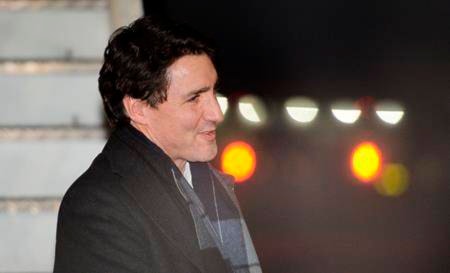Prime Minister Justin Trudeau deflected questions from Donald Trump Tuesday about how much Canada is spending on its military even as the mercurial U.S. president threatened trade action against countries that don’t invest enough in their own defences.
The exchange, in which Trump called Canada “slightly delinquent,” came on the sidelines of a major NATO military alliance meeting Tuesday, the first face-to-face meeting between the two North American leaders since Trudeau won re-election in October.
It also came as other NATO members, including the alliance’s secretary-general and the president of Latvia, where 600 Canadian troops are deployed as a check against Russian aggression, reiterated to The Canadian Press the importance of spending more on defence.
All 29 NATO members agreed in 2014, following Russia’s annexation of Ukraine’s Crimea region, to stop cutting their defence budgets and work toward investing two per cent of their gross domestic products on their militaries within the next decade.
Trump, whose country spends far more on defence than any other NATO member, both in raw cash and as a share of GDP, has personally taken up the target as critical for ensuring all members of the 70-year-old military alliance are contributing their fair share.
The U.S. president appeared ready to give Canada a pass during his meeting with Trudeau, blasting “delinquent” countries that spend one per cent or less of their GDPs on their militaries as “unacceptable” while describing Canada as “just slightly delinquent.”
Canada spends 1.31 per cent of its GDP — a standard measure of the country’s total economic output — on defence.
“They’re getting up to a level that’s getting to be very acceptable,” said Trump, who at one point threatened trade action against countries that aren’t spending enough. Canada, he said, has “been under the two per cent, obviously, but they’re moving up.”
When asked whether Canada should have a plan for meeting the two-per-cent target, Trump joked: “We’ll put Canada on a payment plan.” But then he turned to Trudeau and asked: “What are you at? What is your number?”
It was at that point Trudeau tried to sidestep the question by pointing to his government’s plan, first unveiled in 2017, to increase Canadian defence spending by 70 per cent over the next 10 years, which includes the purchase of new fighter jets and warships.
“OK,” Trump said, before repeating: “Where are you now in terms of your number?”
That prompted Trudeau to look to his delegation, which included Defence Minister Harjit Sajjan, Foreign Affairs Minister Francois-Philippe Champagne and chief of the defence staff Gen. Jonathan Vance, who offered several answers before Trudeau replied with 1.4 per cent.
READ MORE: Trudeau to mark NATO’s birthday amid questions about military alliance’s future
“They’re getting there,” Trump told reporters, seemingly satisfied. “They know it’s important to do that and they’re economy is doing well. They’ll get there quickly, I think. And look, it’s to their benefit.”
The Liberals’ defence plan is only expected to hit 1.4 per cent of GDP in the 2024-25 fiscal year and does not provide any timetable beyond that for reaching two per cent.
Even then, Canada’s figure comes after the Liberals in 2017 changed the way the government calculates its defence spending to include such things as veterans’ programs and the Canadian Coast Guard. The change was approved by NATO.
The Liberal government has refused to say whether it actually believes in the two-per-cent target and has instead repeatedly pointed to Canada’s contributions to NATO missions in Latvia, Iraq and other places as a better measurement of its contributions to the military alliance.
Lee Berthiaume, The Canadian Press
